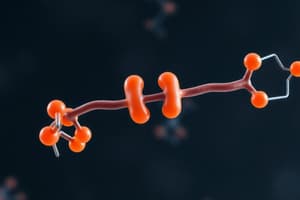Podcast
Questions and Answers
The pyruvate dehydrogenase complex is active during fasting states.
The pyruvate dehydrogenase complex is active during fasting states.
False (B)
Lipoic acid is one of the five cofactors required by the pyruvate dehydrogenase complex.
Lipoic acid is one of the five cofactors required by the pyruvate dehydrogenase complex.
True (A)
The reaction catalyzed by pyruvate dehydrogenase produces NADH, acetyl-CoA, and CO2.
The reaction catalyzed by pyruvate dehydrogenase produces NADH, acetyl-CoA, and CO2.
True (A)
Arsenic exposure can lead to increased activity of pyruvate dehydrogenase by inhibiting lipoic acid.
Arsenic exposure can lead to increased activity of pyruvate dehydrogenase by inhibiting lipoic acid.
Pyruvate carboxylase requires the cofactor B6 for its function.
Pyruvate carboxylase requires the cofactor B6 for its function.
The pyruvate dehydrogenase complex is regulated to be inactive during fed states.
The pyruvate dehydrogenase complex is regulated to be inactive during fed states.
FAD is one of the five cofactors required by the pyruvate dehydrogenase complex.
FAD is one of the five cofactors required by the pyruvate dehydrogenase complex.
Similar to the pyruvate dehydrogenase complex, the α-ketoglutarate dehydrogenase complex uses a distinct set of cofactors.
Similar to the pyruvate dehydrogenase complex, the α-ketoglutarate dehydrogenase complex uses a distinct set of cofactors.
Increased levels of ATP stimulate the activity of the pyruvate dehydrogenase complex.
Increased levels of ATP stimulate the activity of the pyruvate dehydrogenase complex.
One of the clinical findings of arsenic poisoning includes garlic breath.
One of the clinical findings of arsenic poisoning includes garlic breath.
The pyruvate dehydrogenase complex requires five cofactors including copper.
The pyruvate dehydrogenase complex requires five cofactors including copper.
The pyruvate dehydrogenase complex is activated by an increase in the NAD+/NADH ratio.
The pyruvate dehydrogenase complex is activated by an increase in the NAD+/NADH ratio.
Lactic acid dehydrogenase is primarily active in skeletal muscle during anaerobic glycolysis and requires B6 as a cofactor.
Lactic acid dehydrogenase is primarily active in skeletal muscle during anaerobic glycolysis and requires B6 as a cofactor.
Alanine aminotransferase facilitates the transfer of amino groups from the liver to muscle tissue.
Alanine aminotransferase facilitates the transfer of amino groups from the liver to muscle tissue.
Similar to the pyruvate dehydrogenase complex, the α-ketoglutarate dehydrogenase complex utilizes the same cofactors and exhibits a similar action.
Similar to the pyruvate dehydrogenase complex, the α-ketoglutarate dehydrogenase complex utilizes the same cofactors and exhibits a similar action.
The enzyme complex that transitions pyruvate to acetyl-CoA requires a total of four different cofactors.
The enzyme complex that transitions pyruvate to acetyl-CoA requires a total of four different cofactors.
Vitamin B7 is necessary for the functioning of pyruvate carboxylase, which helps replenish the TCA cycle.
Vitamin B7 is necessary for the functioning of pyruvate carboxylase, which helps replenish the TCA cycle.
An increase in ADP would inhibit the activity of the pyruvate dehydrogenase complex.
An increase in ADP would inhibit the activity of the pyruvate dehydrogenase complex.
The presence of arsenic can lead to symptoms including QT prolongation and skin cancer due to inhibition of lipoic acid.
The presence of arsenic can lead to symptoms including QT prolongation and skin cancer due to inhibition of lipoic acid.
Lactic acid dehydrogenase primarily functions in the lungs during aerobic metabolism.
Lactic acid dehydrogenase primarily functions in the lungs during aerobic metabolism.
Flashcards are hidden until you start studying
Study Notes
Pyruvate Dehydrogenase Complex
- A mitochondrial enzyme complex connecting glycolysis and the TCA cycle.
- Regulated differently in fed (active) and fasting (inactive) states.
- Catalyzes the conversion of pyruvate to acetyl-CoA, CO2, and NADH.
- Requires 5 cofactors:
- Thiamine pyrophosphate (B1)
- Lipoic acid
- CoA (B5, pantothenic acid)
- FAD (B2, riboflavin)
- NAD+ (B3, niacin)
Regulation of Pyruvate Dehydrogenase Complex
- Activated by:
- Increased NAD+/NADH ratio
- Increased ADP
- Increased Ca2+
Clinical Findings Related to Arsenic Poisoning
- Arsenic inhibits lipoic acid, impairing the pyruvate dehydrogenase complex function.
- Presentation:
- Pigmentary skin changes
- Skin cancer
- Vomiting
- Diarrhea
- QT prolongation
- Garlic breath
Pyruvate Metabolism
- Different pathways of pyruvate metabolism include:
- Transition to the TCA cycle
- Alanine cycle
- Lactic acid fermentation
- Functions of different pyruvate metabolic pathways (and their associated cofactors):
- Alanine Aminotransferase (B6): Alanine carries amino groups to the liver from muscle.
- Pyruvate Carboxylase (B7): Oxaloacetate can replenish the TCA cycle or be used in gluconeogenesis.
- Pyruvate Dehydrogenase (B1, B2, B3, B5, lipoic acid): Transition from glycolysis to the TCA cycle.
- Lactic acid dehydrogenase (B3): End of anaerobic glycolysis - Major pathway in RBCs, WBCs, kidney medulla, lens, testes, and cornea.
Pyruvate Dehydrogenase Complex
- Mitochondrial enzyme complex linking glycolysis and the TCA cycle.
- Regulated differently in fed (active) and fasting (inactive) states.
- Catalyzes the reaction: pyruvate + NAD+ + CoA → acetyl-CoA + CO2 + NADH.
- Contains 3 enzymes requiring 5 cofactors:
- Thiamine pyrophosphate (B1)
- Lipoic acid
- CoA (B5, pantothenic acid)
- FAD (B2, riboflavin)
- NAD+ (B3, niacin)
- Activated by:
- ↑ NAD+/NADH ratio
- ↑ ADP
- ↑ Ca2+
Clinical Findings: Arsenic Poisoning
- Arsenic inhibits lipoic acid.
- Presentation:
- Pigmentary skin changes
- Skin cancer
- Vomiting
- Diarrhea
- QT prolongation
- Garlic breath
Pyruvate Metabolism
- Pyruvate metabolism is a crucial process, with various pathways branching out from glucose and pyruvate, including the TCA cycle, Alanine cycle, and Lactic acid fermentation.
- Different pyruvate pathways rely on specific cofactors:
- Alanine Aminotransferase (B6): Responsible for transporting amino groups from muscle to the liver.
- Pyruvate Carboxylase (B7): Used in gluconeogenesis and replenishing the TCA cycle.
- Pyruvate Dehydrogenase (B1, B2, B3, B5, lipoic acid): Connects glycolysis to the TCA cycle.
- Lactic acid dehydrogenase (B3): Key enzyme in anaerobic glycolysis.
- Major pathway in RBCs, WBCs, kidney medulla, lens, testes, and cornea.
α-Ketoglutarate Dehydrogenase Complex
- Similar to pyruvate dehydrogenase complex.
- Shares the same cofactors and possesses a similar substrate and action.
- Converts α-ketoglutarate to succinyl-CoA in the TCA cycle.
Pyruvate Dehydrogenase Complex
- Mitochondrial enzyme complex connecting glycolysis with the TCA cycle
- Converts pyruvate into acetyl-CoA
- Requires 5 cofactors: thiamine pyrophosphate (B1), lipoic acid, CoA (B5), FAD (B2), and NAD+ (B3)
- Activated by high NAD+/NADH ratio, high ADP, and high Calcium ions
Clinical Significance of Pyruvate Dehydrogenase Complex
- Arsenic poisoning inhibits lipoic acid, leading to a range of symptoms
- Pigmentary skin changes
- Skin cancer
- Vomiting
- Diarrhea
- QT prolongation
- Garlic breath
Pyruvate Metabolism
- Alanine aminotransferase (B6) uses pyruvate to transport amino groups from muscle to the liver
- Pyruvate carboxylase (B7) converts pyruvate to oxaloacetate, which can replenish the TCA cycle or be used in gluconeogenesis
- Pyruvate dehydrogenase (B1, B2, B3, B5, and lipoic acid) is responsible for transitioning pyruvate from glycolysis to the TCA cycle
- Lactic acid dehydrogenase (B3) catalyzes the conversion of pyruvate to lactate in anaerobic glycolysis, prominent in red blood cells, white blood cells, kidney medulla, lens, testes, and cornea
Similar Complex
- α-ketoglutarate dehydrogenase complex uses the same cofactors and performs a similar reaction as pyruvate dehydrogenase, converting α-ketoglutarate to succinyl-CoA within the TCA cycle
Pyruvate Dehydrogenase Complex
- Mitochondrial enzyme complex: Links glycolysis and the TCA cycle.
- Regulated by metabolic state: Active in the fed state and inactive in the fasting state.
- Reaction: Converts pyruvate to acetyl-CoA, CO2, and NADH.
- Requires 5 cofactors: Thiamine pyrophosphate (B1), lipoic acid, CoA (B5), FAD (B2), and NAD+ (B3).
- Activated by: Increased NAD+/NADH ratio, increased ADP, and increased Ca2+.
Similar Complex: α-Ketoglutarate Dehydrogenase Complex
- Shares cofactors with pyruvate dehydrogenase complex.
- Converts α-ketoglutarate to succinyl-CoA in the TCA cycle.
Clinical Findings Related to Arsenic Poisoning
- Mechanism: Arsenic inhibits lipoic acid, disrupting pyruvate dehydrogenase complex function.
- Presentation: Pigmentary skin changes, skin cancer, vomiting, diarrhea, QT prolongation, and garlic breath (characteristic odor).
Pyruvate Metabolism
- Glucose and Pyruvate: Branch into various metabolic pathways.
- Alanine Cycle: Alanine carries amino groups to the liver from muscle, facilitated by alanine aminotransferase (B6).
- Pyruvate Carboxylase (B7): Converts pyruvate to oxaloacetate, replenishing the TCA cycle or used in gluconeogenesis.
- Pyruvate Dehydrogenase (B1, B2, B3, B5, lipoic acid): Transition from glycolysis to the TCA cycle.
- Lactic Acid Dehydrogenase (B3): End of anaerobic glycolysis, major pathway in erythrocytes (RBCs), leukocytes (WBCs), kidney medulla, lens, testes, and cornea.
Studying That Suits You
Use AI to generate personalized quizzes and flashcards to suit your learning preferences.




